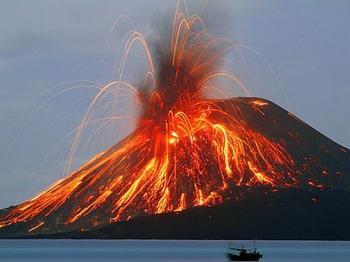 As Anak Krakatau continues to erupt in the Sunda Strait, could we see a repeat of what happened 127 years ago? Here’s a reminder.
As Anak Krakatau continues to erupt in the Sunda Strait, could we see a repeat of what happened 127 years ago? Here’s a reminder.
The best known eruption of Krakatoa culminated in a series of massive explosions on August 26–27, 1883, which was among the most violent volcanic events in modern and recorded history.
With a Volcanic Explosivity Index (VEI) of 6, the eruption was equivalent to 200 megatons of TNT (840 PJ) — about 13,000 times the nuclear yield of the Little Boy bomb (13 to 16 kt) that devastated Hiroshima, Japan, during World War II and four times the yield of the Tsar Bomba (50 Mt), the largest nuclear device ever detonated.
The 1883 eruption ejected approximately 21 km3 (5.0 cu mi) of rock, ash, and pumice.
The cataclysmic explosion was distinctly heard as far away as Perth in Western Australia, about 1,930 miles (3,110 km) away, and the island of Rodrigues near Mauritius, about 3,000 miles (5,000 km) away.
Near Krakatau, according to official records, 165 villages and towns were destroyed and 132 seriously damaged, at least 36,417 (official toll) people died, and many thousands were injured by the eruption, mostly from the tsunamis that followed the explosion. The eruption destroyed two-thirds of the island of Krakatoa.
Eruptions at the volcano since 1927 have built a new island in the same location, named Anak Krakatau (Indonesian: “Child of Krakatoa”). This island currently has a radius of roughly 2 kilometres (1.2 mi) and a high point around 300 metres (980 ft) above sea level, growing 5 metres (16 ft) each year and it is this new island that is erupting now.
Probability of another 1883 style event? We think it is highly likely and what we are seeing now could be the signature of it.


